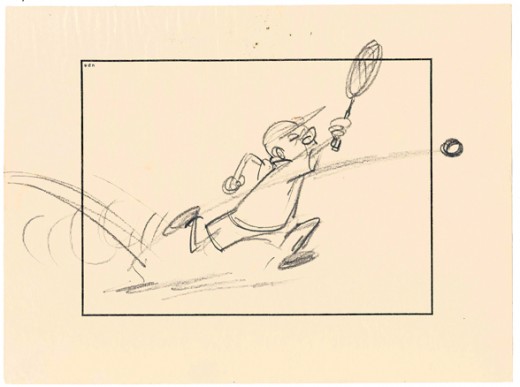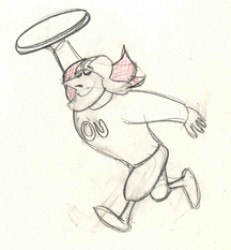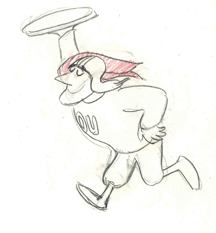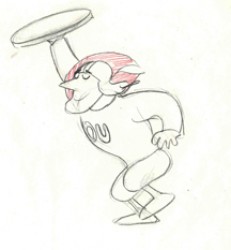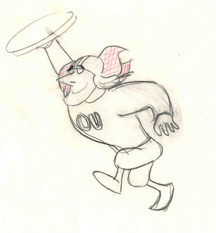Category ArchiveHubley
Hubley &Story & Storyboards &UPA 29 May 2006 08:59 am
Magoo stybd
Animation Artifacts &Hubley 09 May 2006 08:07 am
Rabbits Rabbits Rabbits

- Here, for no good reason, is a layout drawing John Hubley did for his film, People People People.
This was a film done for the 1976 BiCentennial about overpopulation. It is told without dialogue – a musical soundtrack – since it was done for USIA and planned to be shown predominantly outside of the United States to non-English speakers.
(Click on image to enlarge.)
It starts out relatively slowly telling the complete history of the United States in four brisk minutes. The film soon picks up speed to the point where scenes are down to 12, 8, and 6 frames apiece, and pans are whipping miles across the screen. All of it is hitched tightly to Benny Carter’s excellent score.
The layout of rabbits curiously foreshadows the work John would do on Watership Down.
That unfortunate feature has small glimmers of greatness; one wonders what could have happened if an artist had directed the final.
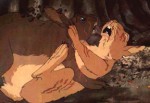 I just went to Funnyworld #20 and reread the article by Michael Barrier. I knew there’d be a good bit to quote: “Fortunately, Rosen* left enough of Hubley in the film to permit us to gauge how differently the two men approached the film: Rosen’s rabbits merely bleed; it is Hubley’s rabbits, in their few minutes of screen time, who live and die.”
I just went to Funnyworld #20 and reread the article by Michael Barrier. I knew there’d be a good bit to quote: “Fortunately, Rosen* left enough of Hubley in the film to permit us to gauge how differently the two men approached the film: Rosen’s rabbits merely bleed; it is Hubley’s rabbits, in their few minutes of screen time, who live and die.”
*The producer turned director who fired John Hubley.
Animation Artifacts &Hubley 16 Apr 2006 08:19 am
Vlasic continued
– Continuing the saga of Vlasic Pickles, the agency approved the stork, Edgar Buchanan 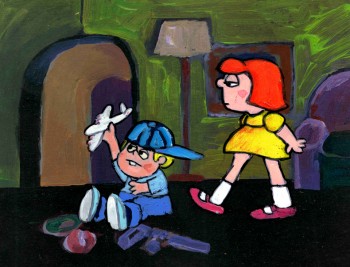 and the plan of action.
and the plan of action.
We’d already finished the first commercial which was on the air. (Represented by the two set-ups posted here. The style was done with acrylic paints – out of a tube – on top of the cel. Ink with Sharpie on cel; paint dark colors – ON TOP of cel – up to and over ink line; after drying paint again with lighter tones, and again. Imagine kids & a gun in a spot today!)
(Click on images to enlarge.)
Phil Duncan did a great job animating it. I inbetweened, and the Agency loved it and approved it to color.
All this time, John and Faith were busy preparing the start of Everybody Rides the Carousel. It was to be three half-hour shows (Eventually CBS changed their mind and asked the shows, still in production, to be reconfigured to make a 90 min film) and was in preproduction. I did the spots on my own with John checking in. Faith wanted nothing to do with a commercial and was somewhat furious that a commercial was ongoing.
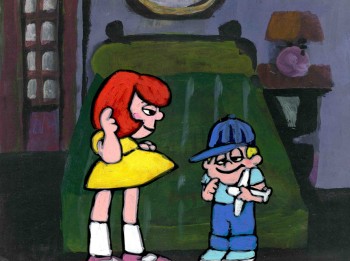 Within weeks the spot was in color and two junior exec. agency guys, John and I stood around the Hubley moviola. (It was a great machine with four sound heads and a picture head that was the size of a sheet of animation paper. Pegs were actually attached to enable rotoscoping!)
Within weeks the spot was in color and two junior exec. agency guys, John and I stood around the Hubley moviola. (It was a great machine with four sound heads and a picture head that was the size of a sheet of animation paper. Pegs were actually attached to enable rotoscoping!)
The two agency guys were buttoned up with good suits and briefcases. They stood behind John and me, and I operated the moviola.
We screened the spot the first time. I turned around and these two guys had come undone. Their ties were loose and astray; they were visibly sweating. I swear this all happened within the course of 30 secs.
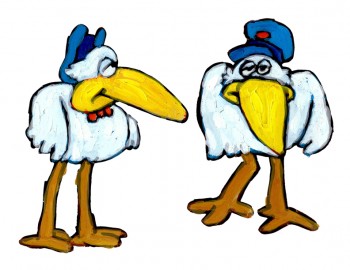 John smiled and optimistically asked how they liked it. They looked at each other, and couldn’t answer. I don’t think they were able to form a decision or say what they actually thought. Eventually, they left with the spot in their briefcase and would get back. It wasn’t good.
John smiled and optimistically asked how they liked it. They looked at each other, and couldn’t answer. I don’t think they were able to form a decision or say what they actually thought. Eventually, they left with the spot in their briefcase and would get back. It wasn’t good.
They did get back. I was asked to pack up all the elements and ship them back to W.B. Doner. The spot was thrown out of the studio by John who refused to change it. (Hubley’s stork.)
He liked what was done, and apparently had a rider in his contract
which covered him – somehow.
The spot showed up at Jack Zander’s studio, Zander’s Animation Parlour. They used the Groucho impersonation and slicked it up a lot. Vlasic is still using that stork, and that was John’s last commercial endeavor.
(Note: Thanks to Mark Mayerson’s comment, yesterday, we know that Pat Harrington was the Groucho impersonator later used for the stork’s voice.)
Animation Artifacts &Hubley 15 Apr 2006 07:49 am
Duncan Stork
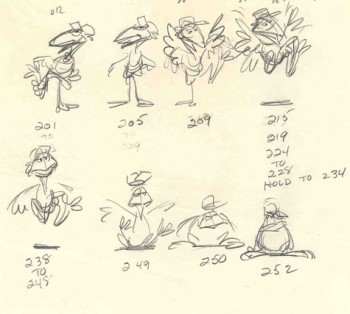 – Years ago I worked at the Hubley studio on a pair of commercials for Vlasic pickles. One of the two spots made it to the air.
– Years ago I worked at the Hubley studio on a pair of commercials for Vlasic pickles. One of the two spots made it to the air.
This is from the spot that never made it.
Vlasic had a commercial they wanted, and because of the agency’s long time relationship with the Hubleys, they came to him to try to develop the character. (The agency was W.B. Doner, the agency that had done so well with Hubley’s Maypo commercials.)
(Click on image to enlarge.)
The agency came with two already-recorded voices: one was a Groucho Marx impersonator (I’m not 100% sure, but I think it may have been Frank Gorshin); the other was character actor, Edgar Buchanan. John wanted Edgar Buchanan – it was a much richer voice, lots of cowboy appeal.
John designed the character to look like one of those stationmasters in cowboy films. The guy who gives out tickets and does morse code when he has to. The stork had a vest and a blue, boxy, stationmaster-type cap cocked off to the side. It was a great character.
Phil Duncan was the animator. A brilliant character guy who had done everything from Thumper to George of the Jungle. I loved cleaning up and inbetwwening his work. It was all fun and vibrating with life.
This pictured piece of art fell out of one of Phil’s packages. It was a thumbnail plan of the action. Phil would do these things which usually stretched around the edges of his final drawings. In a nutshell, you could see the scene and how he worked it out. Lovely stuff.
I felt this drawing was as beautiful as the original animation drawings.
Animation &Hubley &Richard Williams 08 Apr 2006 08:33 am
Rambling Rambling
To put it in a nutshell:
Back in the early ’60′s animation busted out of the studios. The Hubley surprise Tender Game of 1958 was followed by Moonbird in 1959. Suddenly people realized full well that they could use this medium to do more than make people laugh – and they could do it Independently and out of schools and on a shoestring. Annecy and Zagreb showed up to show the films, and a new world was born from the remains of UPA.
Dick Williams did The Little Island. George Dunning did The Flying Man. Borowczyk and Lenica did Dom. Fred Wolf did The Top. Bruno Bozzetto did The Two Castles. The Zagreb studios grew wildly and quickly and made exciting films.
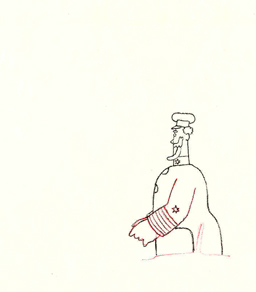 – The first feature to capitalize on this 60′s renaissance of animation (excluding Hubley’s own feature Of Stars and Men) and rehash what had been done by the Independent crowd, was The Yellow Submarine.
– The first feature to capitalize on this 60′s renaissance of animation (excluding Hubley’s own feature Of Stars and Men) and rehash what had been done by the Independent crowd, was The Yellow Submarine.
The Beatles sponsored something just this side of daring. However, those of us in the know were aware that it had already been done in shorts. We’d seen it in festivals. We’d seen it at ASIFA. The modest success of that feature made it more mainstream, and it wasn’t long before Beavis and Butthead came along.
- I remember the streets of New York lined with cels from The Yellow Submarine. Every Manhattan stationery sold them. Marketing. Those cels stayed in store windows for years, it seemed. (click on image to enlarge.) For the most part, they were selling for $75.
I remember not thinking they were worth it.
Today, of course, they sell for $1000 and up, but then it’s probably the same difference given the value of money today.
- I’m glad to see that Bruno Bozzetto will have a retrospective in Ottawa. It was in Ottawa in 1978 that his feature Allegro Non Troppo was a surprise midnight screening. An instant hit with that crowd. No advance publicity had us all walking on heaven when that film ended. I can still remember the bubbling enthusiasm when we left the theater at 1:30am. It was an animator’s delight. It’ll be nice to see the return to Ottawa.
(New Yorkers will have a special ASIFA East meeting to honor Bozzetto and see his films just prior to Ottawa in September.)
Animation Artifacts &Comic Art &Hubley 25 Mar 2006 07:41 am
Letterman I, II, & III
Trying to recover some of the highlights from the past two weeks, I’m reposting these items from the Letterman series done for The Electric Company, starting back in 1972.
- These drawings are animation drawings of a run cycle done by Tissa David for the first season of the show.
There were three seasons of Letterman episodes we did at the Hubley Studio. All 60 episodes were 2 1/2 mins. apiece including the reused wrap-around: “It’s a bird! It’s a plan! It’s Letterman!” They were all directed by John Hubley. The first 40 episodes were all done in-house. The last 20 episodes were split with 10 done in the NY studio and 10 farmed out to Fred Wolf‘s studio in LA. The boards and layouts in NY for those sent out. Fred and Chuck Swenson animated all 10. (These are also the only episodes to use cel vinyl.) The audio was done in NY, and editing was done in the studio by Faith Hubley.
In the first season of the show the primary voices were: Gene Wilder as Letterman, Zero Mostel as Spellbinder, Joan Rivers as the Narrator, and Jack Gilford doing incidental voices. Billy Taylor did the music.
II
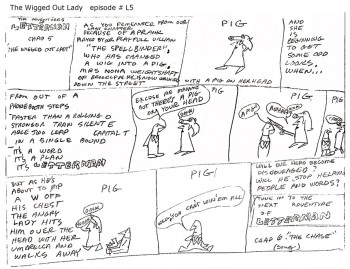 Christopher Cerf wrote all 60 episodes of Letterman, probably in collaboration with John Hubley. The storyboard posted here for episode #5 was by Chris Cerf; that’s pretty much how he did the scripts.
Christopher Cerf wrote all 60 episodes of Letterman, probably in collaboration with John Hubley. The storyboard posted here for episode #5 was by Chris Cerf; that’s pretty much how he did the scripts.
It’s undeniable that the wacky “naive” drawings undoubtedly inspired the models for the characters in the films.
(Click on any image to enlarge to a readable size.)
No doubt also affecting the models was an acccident that John Hubley had had at the start of production on this first series. At a dinner party, John tried to stop a falling 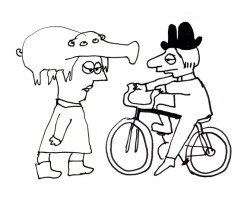 fondue pot filled with melted cheese. Horrible burns over both hands somewhat hampered his artwork. I would make several visits a day to his nearby apartment to have art approved. To have John draw, we’d prop a felt-tip pen into the mass of gauze and cotton and bandages wrapped around both hands. He’d move his wrapped fist around a sheet of paper and end up with a model like the one posted here. This went on for about three weeks (roughly half of the production time.) When he returned, backgrounds were done at a super speed.
fondue pot filled with melted cheese. Horrible burns over both hands somewhat hampered his artwork. I would make several visits a day to his nearby apartment to have art approved. To have John draw, we’d prop a felt-tip pen into the mass of gauze and cotton and bandages wrapped around both hands. He’d move his wrapped fist around a sheet of paper and end up with a model like the one posted here. This went on for about three weeks (roughly half of the production time.) When he returned, backgrounds were done at a super speed.
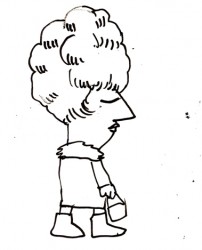
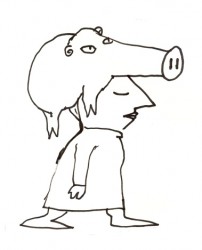 Everything was modeled on Krazy Kat. Lots of white space with sparkling color sprinkled about. The lines were dressed up with a ragged cross-hatching. The characters were colored with magic marker. (John’s favorite color was Eberhard Faber’s “Shock Pink”. Letterman’s skin color took this tone. It showed up in almost everything John did with markers.) The backgrounds were inked with a pentel felt-tip. John would throw a light wash of water over some of these lines to get them to bleed.
Everything was modeled on Krazy Kat. Lots of white space with sparkling color sprinkled about. The lines were dressed up with a ragged cross-hatching. The characters were colored with magic marker. (John’s favorite color was Eberhard Faber’s “Shock Pink”. Letterman’s skin color took this tone. It showed up in almost everything John did with markers.) The backgrounds were inked with a pentel felt-tip. John would throw a light wash of water over some of these lines to get them to bleed.
We’d race daily to get at least half a dozen scenes ink, painted and colored on paper. Then it’d be packaged and sent out via Fed Ex. (Celine Miles in LA cut & pasted the colored drawwings to cels; the art was shot at Animcam by Jack Buehre.) The FedEx guy arrived daily at 5:30pm, so that was my deadline. I found myself coming in at 7am to add more time to the day. I’d watch the clock which ticked furiously; I averaged 30secs to ink a drawing – any more, and I wouldn’t make Faith’s deadline.
III
 – These scrappy examples are not the best to give an indication of Letterman. But they were the ones I saved, so they’ll have to do. John Hubley drew these very early in the production, and they undoubtedly owe something to Chris Cerf‘s hilarious storyboards.
– These scrappy examples are not the best to give an indication of Letterman. But they were the ones I saved, so they’ll have to do. John Hubley drew these very early in the production, and they undoubtedly owe something to Chris Cerf‘s hilarious storyboards.
The animators involved in season one included: Tissa David, Johnny Gentilella, Vinnie Bell, Lu Guarnier and Jack Schnerk.
Helen Komar, a veteran Asst. Animator in NY, was the coordinator of the production and Gen Hirsch also colored. Gen and I got really close over the couple of years we worked together. She was the wife of Joseph Hirsch, the brilliant artist and mother of Paul Hirsch (editor of Star Wars and other incredible films) .
It was my first real job in an animation studio. Probably for this reason, I remember a lot of what happened – it was indelibly etched in my memory. I was the inker, colorist (we used markers, remember), animator of miscellaneous scenes (I think I animated some 40 scenes that first season), hole puncher, and Assistant Animator.
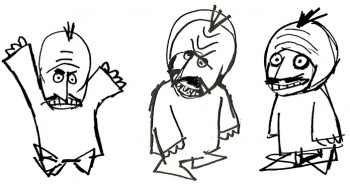 It was in the capacity as Assistant Animator that I found trouble. I hadn’t done it before, except for myself, so was horribly untrained. Because the schedule was so ridiculously tight, I had to assist in ink (Sharpie pens – the fat ones that dribbled ink and bled through multiple sheets of paper) and correctly put some of the animation – I won’t say on model, but closer to model.
It was in the capacity as Assistant Animator that I found trouble. I hadn’t done it before, except for myself, so was horribly untrained. Because the schedule was so ridiculously tight, I had to assist in ink (Sharpie pens – the fat ones that dribbled ink and bled through multiple sheets of paper) and correctly put some of the animation – I won’t say on model, but closer to model.
Johnny Gentilella, an absolutely wonderful guy, was the farthest astream. He was THE Popeye animator at Paramount. His characters looked like Paramount characters, and I had to get them closer to John’s style. This meant assisting (in ink), inbetweening and basically redrawing everything he’d done – in a rush – without proper training. The guilt of what I was doing to Johnny’s drawings weighed heavily on me, and I eventually apologized to him for what I’d done. He laughed and told me that he had no problem with it. This was standard for NY production in those days and he was used to it. (As a matter of fact, he hired me for another job he directed months later. So I guess he wasn’t too upset. I was.)
The race against the clock was always on; my career had started, and it couldn’t have been more fun. And I was working for John Hubley.
Commentary &Hubley &UPA 28 Feb 2006 08:51 am
Reminiscing
A couple of things yesterday turned me toward the past.
- Three celebrities died over the weekend. I only had an actual communication with one of them. ABEL’S ISLAND was in the throes of new production. Tim Curry had been recorded and edited in London, and I was riding the high of his voice. We were about to record Heidi Stallings as Amanda, Abel’s wife and had one principal voice left to cast and record.
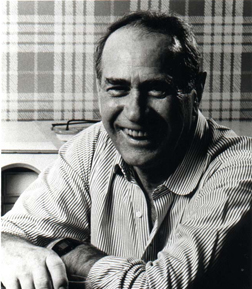 Darren McGavin was performing in a local off-Broadway production. His voice would be perfect for Gower, the frog, the only one to see Abel during his castaway year.
Darren McGavin was performing in a local off-Broadway production. His voice would be perfect for Gower, the frog, the only one to see Abel during his castaway year.
I searched high and low for an agent. I looked through all the guides. I called Actor’s Equity, SAG, NABET. No one had any link to him. Finally, in desperation I called the theater management and explained my position asking if they could kindly relay the message to Mr. McGavin’s agent or manager. It took a couple of days, and I received a call from Darren McGavin, himself. He was furious with me and took out his anger on the phone. The tone of the call was to ask how dare I go through the back door and insult him like this! I tried to be positive, I tried to be courteous, I tried to explain my low position. Eventually, he asked me to send him the script and he would consider it.
However, the bad footing I’d made could not be repaired, and I wanted no bad vibes to enter my film. Gower could have not a tad of anger in his existence. Lionel Jeffries, a brilliant character actor and director, was playing on Broadway opposite Peter O’Toole’s Henry Higgins. Lionel Jeffries voiced Gower brilliantly.
I’m truly sorry I did not get to work with Darren McGavin; I thought him a brilliant actor and a part of my mind’s ether. I’m sorry to see him gone.
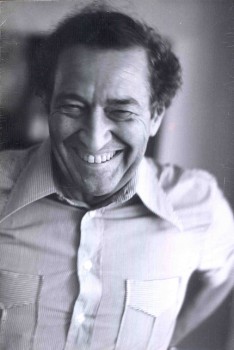 - T. Bosustow visited yesterday and I reviewed any thoughts or comments I had about UPA’s films and personalities with him. The session remained with me, and thoughts of UPA were present all day. Rooty Toot Toot kept replaying in my mind to the point where I have to search it out and watch it today.
- T. Bosustow visited yesterday and I reviewed any thoughts or comments I had about UPA’s films and personalities with him. The session remained with me, and thoughts of UPA were present all day. Rooty Toot Toot kept replaying in my mind to the point where I have to search it out and watch it today.
That film was an enormous influence on me.
I think it’s one of the top five animated films of all time and should be seen over and over by animators as a reminder of what their goals should be while working in this business.
If John Hubley had not had his company, Storyboard Productions, he still would have entered the animation pantheon because of this film.
Fortunately, those in LA will have an opportunity to see it projected on a big screen on March 26th at the Egyptian Theater.
My favorite photo of John Hubley.
(Click on images to enlarge.)
- To GOOGLE Rooty Toot Toot brings you to a small chatty comment on political radio broadcaster Wendy Wilde’s blog. There’s a short poem by Walt Kelly quoted there. It relates to the Blacklist permeating the entertainment business at the time of writing. (Maybe the film relates to this as well. Maybe both relate to what’s going on in the political air today.)
The rooty toot toot of the very minute,
The booty boot boot of the band,
The cutey cute cute of the less than astute,
Shivers and shudders the land.
I thank Kathryn Eagan for posting this poem on that site so I would get to see it.
Animation Artifacts &Hubley 24 Jan 2006 10:02 am
Babbitt Mime
Michael Barrier‘s posted response to Karin Babbitt‘s letter, yesterday, brought back memories. This story has followed me most of my career and always has me a bit split. Since I both direct films and animate them, I see both sides of a coin. I dont remember ever talking about it to anyone.
The picture Michael Barrier painted of Art Babbitt and the letter sent him by Steve Worth both talk about the same man I came to know during the making of Richard Williams‘ film, Raggedy Ann & Andy. Whenever Art was in town there was always a dinner at Tissa David‘s or my apartment, or there was jazz late nights with Dick & Art. Some of these moments were part of the treasure of my life.
 However years before meeting him, I got to know Art Babbitt’s animation. I, of course, already knew about his animation from books and films. I’d been watching it carefully for over 20 years before working on John Hubley‘s film, Everybody Rides The Carousel. On that film we became a bit more intimate.
However years before meeting him, I got to know Art Babbitt’s animation. I, of course, already knew about his animation from books and films. I’d been watching it carefully for over 20 years before working on John Hubley‘s film, Everybody Rides The Carousel. On that film we became a bit more intimate.
Art was animating the narrator of the film, a mime. The mime had no mouth, but we heard his voice (actor, Alvin Epstein) throughout the show. After art completed his first animation, it was photographed in LA by Nick Vasu at Dickson/Vasu, and it was one of the first pencil tests to come back to us. (As a matter of fact, it was one of the only pencil tests to be shot for that film.)
 I worked two rooms away from the editing room (two upright moviolas, one with an animation paper-sized viewing screen) across from the kitchen in the art room. One day, John came running in to call me out – this was unusual. It was obviously urgent and I ran behind him to the editing room. When we got into the close quarters, he asked if I wanted to see “one of the greatest peices of animation you’ll ever see.” I knew it’d be the mime. The moviola buzzed and played that opening scene. It was stunning.
I worked two rooms away from the editing room (two upright moviolas, one with an animation paper-sized viewing screen) across from the kitchen in the art room. One day, John came running in to call me out – this was unusual. It was obviously urgent and I ran behind him to the editing room. When we got into the close quarters, he asked if I wanted to see “one of the greatest peices of animation you’ll ever see.” I knew it’d be the mime. The moviola buzzed and played that opening scene. It was stunning.
John was right, the scene was beautiful. It was all on ones and twos, mostly twos. All the drawings were tightly placed and beautifully – I mean beautifully – traced back. Art had done all of the drawings himself.
After it finished playing, we just looked at each other. John had to share it with someone who he knew would appreciate the virtuosity on display. I did. We ran it a couple more times, and I went back to work inspired.
 Months later – most of Art’s work had been completed and was already colored. The untrained inker had loosened the line a bit using colored marky brand markers, though a light watercolor wash had softened the line. Gold and blue were the watercolored washes that had colored the mime’s blouse. Charcoal grey tights. Drawing for drawing, I thought it still looked stunning.
Months later – most of Art’s work had been completed and was already colored. The untrained inker had loosened the line a bit using colored marky brand markers, though a light watercolor wash had softened the line. Gold and blue were the watercolored washes that had colored the mime’s blouse. Charcoal grey tights. Drawing for drawing, I thought it still looked stunning.
The program was scheduled as three half-hour shows on CBS. They would air just prior to their new season. Roughly 18 minutes of new material per program with reuse bits from the previous shows filling the three 24 minute episodes. But just as we were coming to the deadline, CBS had decided to air it all at once – a 90 minute program. Lots more had to be added to the overall length to make it work – rushed animation to make an incredible deadline!
Suddenly it was decided that more of Art’s mime would have to appear. John came up with a technique he said he’d developed on Fantasia. John said he’d shown it to Dick Williams; now he was showing it to me. Basically, it was a camera trick that amounted to 2 frame disssolves from one drawing to the next. Animation was slowed down. I was the one forced to reexpose Art’s scenes and prepare them for the cameraman, Nick Vasu. He couldn’t make any mistakes in the double exposed photography or it’d be difficult to correct.
The budget and schedule had forced John to resort to a trick on animation that he thought was perfect when it had first arrived. Believe me it worked stunningly well within the scenes Art had done. Barrie Nelson had animated a lot of the other mime scenes, but his movement was different and couldn’t be successfully shot the same way. Nor could the budget afford more of the same.
 Art, of course, was upset. He knew he had done a good job and didn’t like that the timing on his animation had been changed. This information came to me via Dick; I’d brought him to the premiere screening of Carousel.
Art, of course, was upset. He knew he had done a good job and didn’t like that the timing on his animation had been changed. This information came to me via Dick; I’d brought him to the premiere screening of Carousel.
I understood Art’s complaint. He had made something he felt was wonderful, and it had been damaged. It wasn’t what he had wanted it to be. I also saw the dilemma John had faced with his budget, his schedule, his need to make the best possible film under the circumstances given him.
And I saw the film. The scenes not only work, but they still have the majesty that Art wanted and the length John needed.
Hubley &Tissa David 14 Jan 2006 08:57 am
Hubley AT&T Spot
We are all a product of our influences. My initial animation experience was with John & Faith Hubley. I quickly learned from them that there was usually a wealth of good references behind any film. When we worked on Voyage To Next, Paul Klee’s paintings were everywhere. His art, from a particular period, influenced everything. I’m not sure how much of his visual style made it to the film, but he was the spirit we tried to imbue into the artwork. When we did the 60 episodes of Letterman for The Electric Company, Krazy Kat and George Herriman‘s art was everywhere.
The only time John referenced other cartoons and/or cartoon art to me was to tell me to take the “Terrytoons” out of the eyes an animator had drawn in a scene. Then he gave me a two minute comparison of eyes from “Disney,” “Terrytoons,” and “Warners.” It was pretty funny, and he could draw them in a heartbeat. All joking aside, it was obvious by the time we’d finished talking that there was, “none of that, here.” Life was our model.

I took some frame grabs off an AT&T commercial animated by Tissa David in the early 70′s. It’s amazing what art made it to the commercials back then! Even with the color deterioration of the print, it’s outrageous material. A couple meet cute on a tightrope, they have a relationship, and it ends in an engagement. All in 30 secs. All in abstraction.
Animation &Commentary &Hubley 24 Dec 2005 08:47 am
Hubley Pick-me-up
Whenever I feel a bit dull creatively, I force myself to think about a Hubley film or two, and that often helps. I worked with the Hubleys for a number of my impressionable, early years (I had found them as film makers much earlier – I was 16). Oddly the films done before I worked with the duo are more inspiring to me.
 A site which helps revitalize some of my memories of their films is: Independent Spirits . It was developed in conjunction with a documentary film, also titled Independent Spirits, by director Sybil DelGaudio & producer Patty Wineapple. All of the work of the Hubleys is featured. Though the site is a bit outdated, it does offer lots of accurate information and stills. It also gives information about the documentary.
A site which helps revitalize some of my memories of their films is: Independent Spirits . It was developed in conjunction with a documentary film, also titled Independent Spirits, by director Sybil DelGaudio & producer Patty Wineapple. All of the work of the Hubleys is featured. Though the site is a bit outdated, it does offer lots of accurate information and stills. It also gives information about the documentary.
